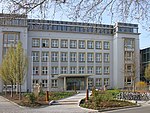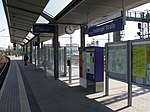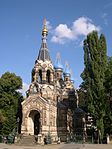Zionskirche, Dresden

The Zionskirche is the name given to two Evangelical Lutheran church buildings in the Südvorstadt district of Dresden. The first, the Alte Zionskirche, was built by Schilling & Graebner from 1908 to 1912. This building was hit and badly damaged by fire during the bombing in February 1945. A temporary roof was later added and it is now preserved as a ruin, housing a lapidarium with 3000 sculptures. The parish, meanwhile, was housed in a barracks next to the ruins until the first stone of a new building, the Neue Zionskirche, was laid on Bayreuther Straße on 5 June 1981, as a gift from the Church of Sweden. With its construction overseen by Eberhard Burger, the new building was inaugurated on 31 October 1982.
Excerpt from the Wikipedia article Zionskirche, Dresden (License: CC BY-SA 3.0, Authors, Images).Zionskirche, Dresden
Nürnberger Straße, Dresden Plauen (Plauen)
Geographical coordinates (GPS) Address Website Nearby Places Show on map
Geographical coordinates (GPS)
| Latitude | Longitude |
|---|---|
| N 51.035833333333 ° | E 13.717222222222 ° |
Address
Alte Zionskirche
Nürnberger Straße
01187 Dresden, Plauen (Plauen)
Saxony, Germany
Open on Google Maps









